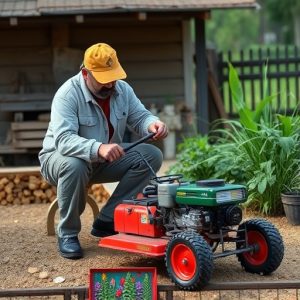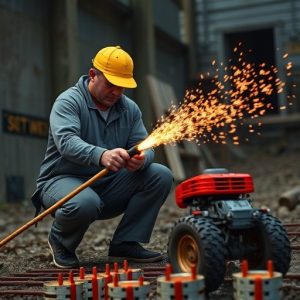Mastering Kubotan Self-Defense: An Essential Guide to Techniques and Application
The Kubotan is a self-defense tool resembling a pen and integral to advanced martial arts technique…….
The Kubotan is a self-defense tool resembling a pen and integral to advanced martial arts techniques, particularly within American Kenpo styles and Ed Parker Karate. First introduced in the 1950s by Ed Parker, this compact weapon enhances hand and finger strike effectiveness, providing users with an extended reach and improved combat efficacy. Its precision design allows for targeted strikes and control techniques that can immobilize attackers. Mastery of the Kubotan involves understanding its diverse applications, including as a striking tool and for managing attackers through pressure points and holds. It is also effective against other weapons like knives and sticks, making it an essential part of self-defense strategies. Integrating the Kubotan into martial arts training can significantly enhance combat skills, but this requires expert instruction to use it safely and effectively. The Kubotan's robust construction, key characteristics such as its blunt rounded end and midpoint button or bead, facilitate both concealment and ready access during confrontations, with impactful strikes capable of distracting or incapacitating an adversary. Knowledge of its components and integration into various self-defense techniques is crucial for effective use. Proficiency with the Kubotan necessitates consistent training, focusing on precise and targeted strikes to vulnerable points, and it should be used strategically to exploit weaknesses in an attacker's defenses. How to use a Kubotan effectively involves drills, guided practice, and exercises that mimic real-world encounters, ensuring ambidextrous proficiency for a range of self-defense scenarios. It is a versatile and effective instrument for personal protection, particularly within the context of Eskrima and Filipino Martial Arts disciplines, where it expands one's martial arts skill set and prepares for a diverse range of potential confrontations.
Explore the art of self-defense with an in-depth look at Kubotan fighting techniques, a discipline that empowers practitioners with the strategic use of a compact self-defense tool. This article serves as your guide to mastering the Kubotan, from its origins and essential features to the precise application of its strikes, ensuring you understand how to use a Kubotan effectively within your martial arts practice. Whether you’re an experienced martial artist or new to self-defense, these techniques will enhance your skills and provide confidence in protecting yourself. Join us as we delve into the intricacies of integrating the Kubotan into your training regimen for practical applications that could be critical in real-world situations.
Understanding the Kubotan: A Comprehensive Guide to Its Origins and Application
The Kubotan is a self-defense tool that has gained prominence in martial arts, particularly within the styles derived from Ed Parker’s American Kenpo. This compact, pen-like device serves as an extension of the hand and fingers, enhancing one’s striking power and range during combat situations. Its origins trace back to the 1950s when it was introduced by instructor Harry Nakamoto at a martial arts seminar hosted by Ed Parker, a renowned figure in the Americanization of Karate. The Kubotan’s design allows for precise strikes and control techniques that can neutralize an attacker, making it a valuable asset in self-defense scenarios.
Understanding how to use a Kubotan effectively requires knowledge of its various applications. It can be employed as a striking weapon, delivering powerful jabs and hooks with the hard end of the device, or used to manipulate and immobilize an opponent’s limbs through pressure points and control holds. The Kubotan’s application also extends to defense against weapons such as knives and sticks. Practitioners often integrate the Kubotan into their training regimen by practicing techniques that combine strikes with traditional martial arts maneuvers, creating a harmonious blend of skill and tool use. Proper usage of the Kubotan necessitates rigorous practice under the guidance of an experienced instructor to ensure proficiency and safety.
The Anatomy of a Kubotan: Key Features and How They Enhance Self-Defense Techniques
The Kubotan is a self-defense tool that has gained popularity due to its effectiveness in various martial arts, particularly Ed Parker Karate. This compact, key-like device may seem unassuming, but it is engineered with precision to augment self-defense techniques. Its primary features include a hard, durable body capped with a rounded end and a button or bead near the midpoint. The Kubotan’s dimensions allow for easy concealment while remaining accessible during confrontations. The hardness of the Kubotan serves to deliver impactful strikes, creating an effective distraction or incapacitating an attacker. The midpoint button or bead is a crucial feature that enhances grip stability and can be used for pressure point application, adding to the user’s defensive maneuvers. When wielded correctly, a Kubotan can extend the reach of the hand, allowing for attacks from a safer distance. Understanding how to use a Kubotan effectively involves mastering its anatomy and incorporating it into strikes, blocks, and control techniques, which can be learned through dedicated practice and proper instruction. The tactile elements of the Kubotan ensure that it becomes an extension of the user’s hand, allowing for precise and targeted self-defense applications. Proper technique involves not only the physical application but also the strategic use of the Kubotan to exploit vulnerabilities in an assailant’s defenses, making it a versatile tool for personal protection.
Mastering Kubotan Strikes: Targeting Vital Points for Effective Defense
Mastery of Kubotan strikes is a critical aspect for those seeking an effective self-defense tool. The Kubotan, a short, thick stick with a blunt end, is designed to extend one’s striking power and can be used in various ways to target vital points on an assailant. Practitioners of the art must understand the anatomical weak spots that a Kubotan strike can exploit. A key element in using a Kubotan effectively is learning to strike with precision, aiming for areas like the eyes, nose, throat, and joints, which are sensitive and can incapacitate an opponent quickly. Proper technique involves holding the Kubotan between the forefinger and thumb, with the rest of the hand encircling it for control and leverage. The strikes should be deliberate and focused, ensuring that the force is applied correctly to maximize effectiveness while minimizing the risk of injury to the defender. Training in this discipline requires dedication and practice to refine one’s accuracy and power, making the Kubotan a potent tool for self-defense when employed by a skilled individual. Understanding the dynamics of each strike, from palm heel strikes to hammerfists, and integrating them into fluid movements are essential components of mastering Kubotan techniques. Regular drills and sparring with a knowledgeable instructor will enhance one’s ability to use a Kubotan effectively in real-world defensive situations.
Integrating the Kubotan into Your Martial Arts Practice: Drills, Training Tips, and Real-World Applications
The Kubotan is a versatile self-defense tool that has become an integral part of many martial arts practices, particularly those influenced by Eskrima and Filipino Martial Arts. Integrating the Kubotan into your training regimen can enhance your skill set, offering new techniques to employ in both controlled drills and real-world self-defense scenarios. To effectively use a Kubotan, begin with mastering its basic handling. Practice gripping the Kubotan correctly, as this will affect the execution of all subsequent moves. Drills that focus on proper grip and stance can be performed solo or with a partner, allowing you to familiarize yourself with the tool’s balance and weight distribution.
Progressive training with the Kubotan should include a variety of drills that cover both offensive and defensive maneuvers. These drills can range from simple blocks and parries to complex disarming and striking techniques. A key aspect of Kubotan practice is learning to channel your energy efficiently, which can be achieved through fluid motion exercises that simulate self-defense situations. Training tips include practicing with both hands to develop ambidextrous proficiency, starting with slow, deliberate movements before transitioning to faster, more dynamic applications. Additionally, incorporating the Kubotan into sparring sessions can provide valuable insights into its real-world applications, teaching you how to use a Kubotan effectively within the unpredictability of combat. Remember to adhere to safety protocols when practicing with the Kubotan, ensuring both your well-being and that of your training partners. By integrating the Kubotan into your martial arts practice, you expand your defensive capabilities, preparing yourself for a broader range of self-defense scenarios.


